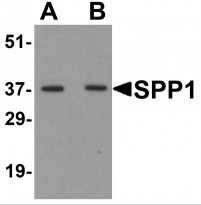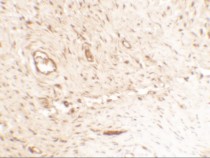ARG55186
anti-OPN / Osteopontin antibody
anti-OPN / Osteopontin antibody for ELISA,ICC/IF,IHC-Formalin-fixed paraffin-embedded sections,Western blot and Human,Mouse,Rat
Cancer antibody; Cell Biology and Cellular Response antibody; Developmental Biology antibody; Signaling Transduction antibody
Overview
| Product Description | Rabbit Polyclonal antibody recognizes OPN / Osteopontin |
|---|---|
| Tested Reactivity | Hu, Ms, Rat |
| Tested Application | ELISA, ICC/IF, IHC-P, WB |
| Host | Rabbit |
| Clonality | Polyclonal |
| Isotype | IgG |
| Target Name | OPN / Osteopontin |
| Antigen Species | Human |
| Immunogen | Synthetic peptide (18 aa) within aa. 50-100 of Human OPN / Osteopontin. |
| Conjugation | Un-conjugated |
| Alternate Names | BSPI; ETA-1; Uropontin; Osteopontin; Nephropontin; SPP-1; Bone sialoprotein 1; BNSP; Urinary stone protein; OPN; Secreted phosphoprotein 1 |
Application Instructions
| Application Suggestion |
|
||||||||||
|---|---|---|---|---|---|---|---|---|---|---|---|
| Application Note | * The dilutions indicate recommended starting dilutions and the optimal dilutions or concentrations should be determined by the scientist. | ||||||||||
| Positive Control | Human Bladder Tissue Lysate |
Properties
| Form | Liquid |
|---|---|
| Purification | Protein A purified. |
| Buffer | PBS and 0.02% Sodium azide |
| Preservative | 0.02% Sodium azide |
| Concentration | 1 mg/ml |
| Storage Instruction | For continuous use, store undiluted antibody at 2-8°C for up to a week. For long-term storage, aliquot and store at -20°C or below. Storage in frost free freezers is not recommended. Avoid repeated freeze/thaw cycles. Suggest spin the vial prior to opening. The antibody solution should be gently mixed before use. |
| Note | For laboratory research only, not for drug, diagnostic or other use. |
Bioinformation
| Database Links | |
|---|---|
| Gene Symbol | SPP1 |
| Gene Full Name | secreted phosphoprotein 1 |
| Background | The secreted protein 1 (SPP1), also known as osteopontin, is a major noncollagenous protein of bone, but is also found in the extracellular matrix of other mineralized tissues and in bodily fluids. In bone, SPP1 is produced by osteoblasts, osteocytes, macrophages, and osteoclasts. SPP1 binds to cells through integrin and non-integrin receptors, as well as the adhesion receptor CD44 in an RGD-independent manner, enabling SPP1 to induce a number of functional effects including macrophage chemotaxis, cytoprotection, and regulation of T helper type 1 cells. SPP1 can regulate biomineralization by inhibiting the formation of hydroxyapatite and the growth of calcium oxalate crystals. |
| Function | Binds tightly to hydroxyapatite. Appears to form an integral part of the mineralized matrix. Probably important to cell-matrix interaction. Acts as a cytokine involved in enhancing production of interferon-gamma and interleukin-12 and reducing production of interleukin-10 and is essential in the pathway that leads to type I immunity. [UniProt] |
| Highlight | Related products: OPN antibodies; OPN ELISA Kits; Anti-Rabbit IgG secondary antibodies; Related news: The role of HDGF in tumor angiogenesis |
| Research Area | Cancer antibody; Cell Biology and Cellular Response antibody; Developmental Biology antibody; Signaling Transduction antibody |
| Calculated MW | 35 kDa |
| PTM | Extensively phosphorylated by FAM20C in the extracellular medium at multiple sites within the S-x-E/pS motif. N- and O-glycosylated. Isoform 5 is GalNAc O-glycosylated at Thr-59 or Ser-62. |
Images (3) Click the Picture to Zoom In
-
ARG55186 anti-OPN / Osteopontin antibody IHC image
Immunohistochemistry: SPP1 in Human bladder tissue stained with ARG55186 anti-OPN / Osteopontin antibody at 20 ug/ml dilution.
-
ARG55186 anti-OPN / Osteopontin antibody WB image
Western blot: Human bladder tissue lysate stained with ARG55186 anti-OPN / Osteopontin antibody at (A) 1 and (B) 2 ug/ml dilution.
-
ARG55186 anti-OPN / Osteopontin antibody IHC image
Immunohistochemistry: Human bladder tissue stained with ARG55186 anti-OPN / Osteopontin antibody at 5 ug/ml dilution.








